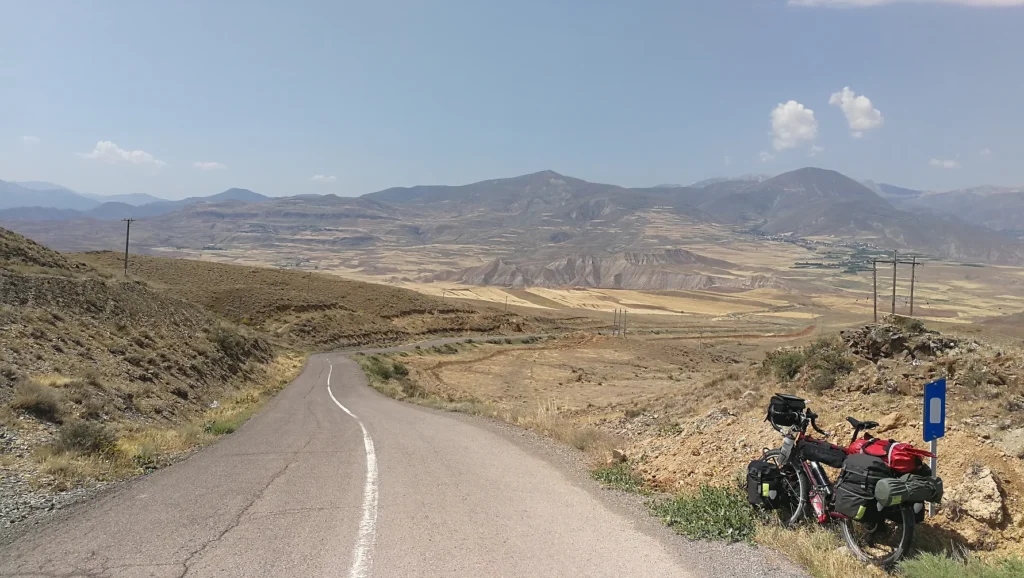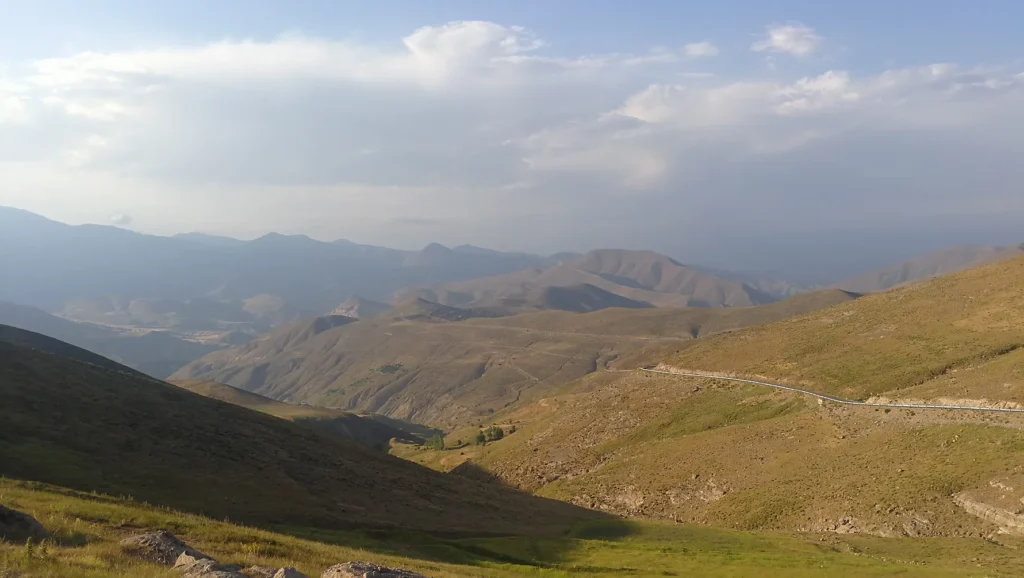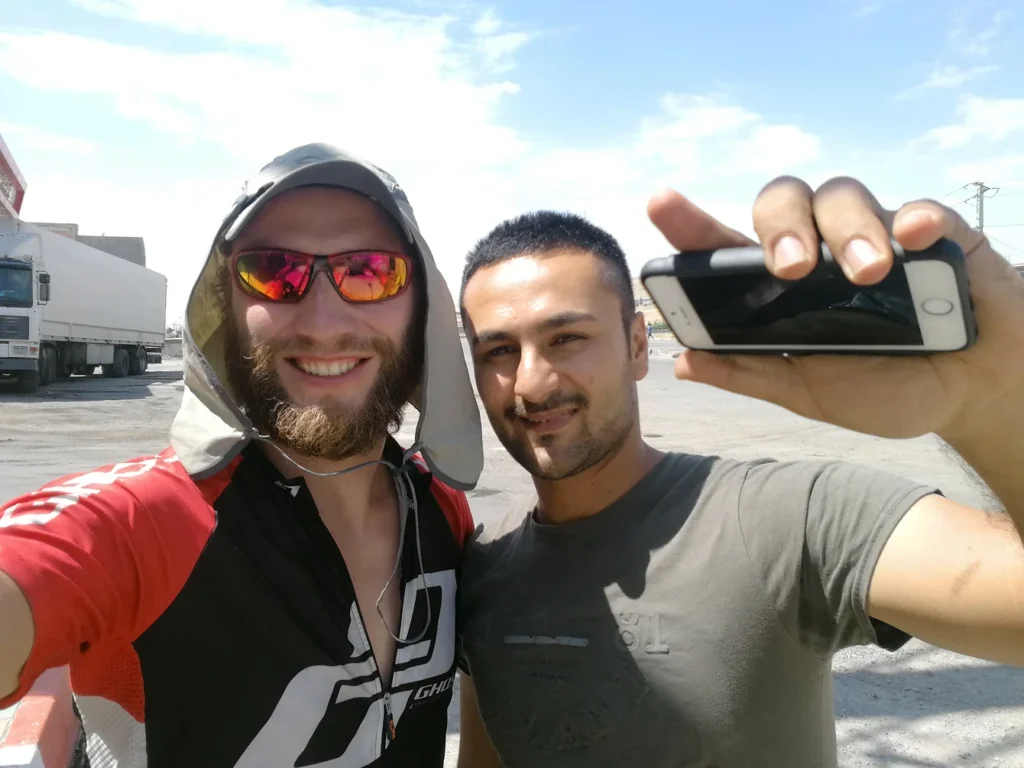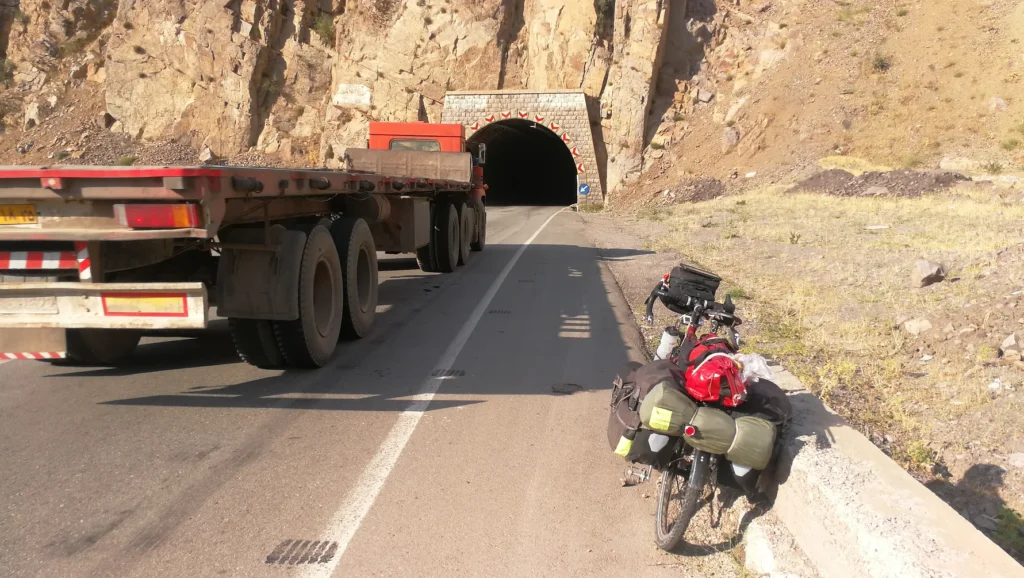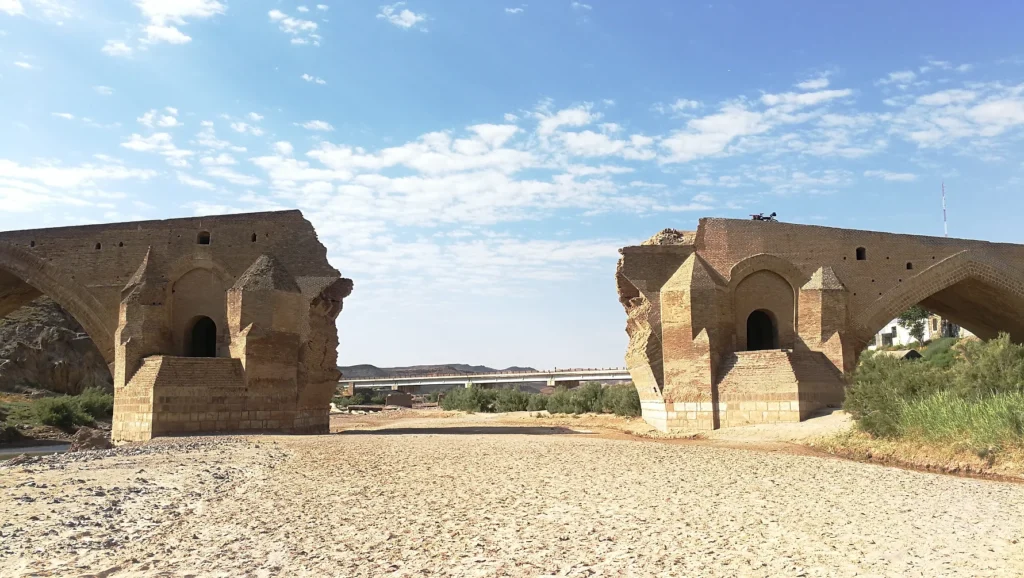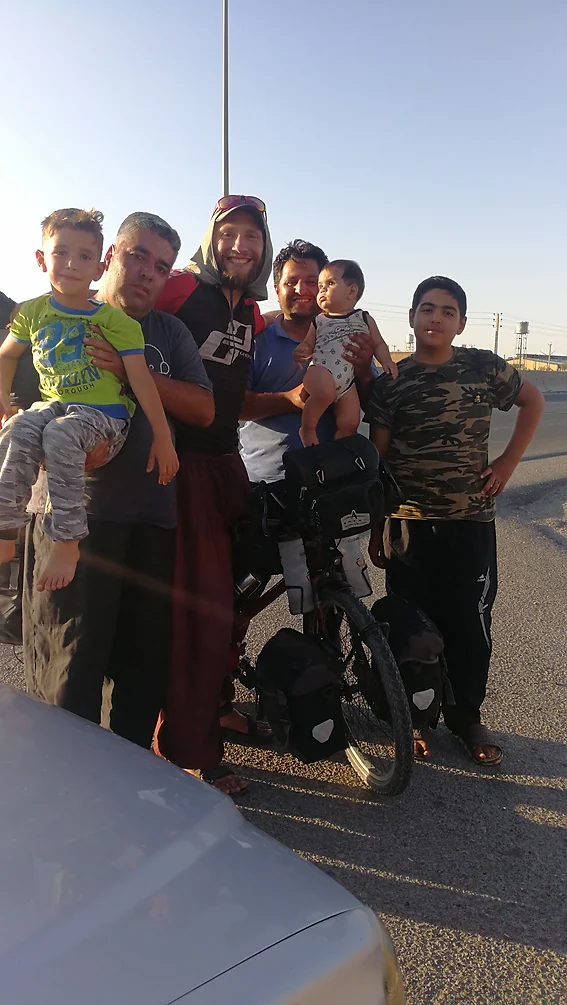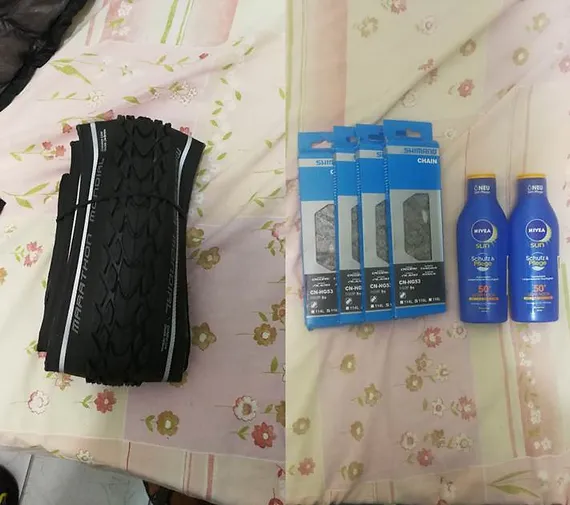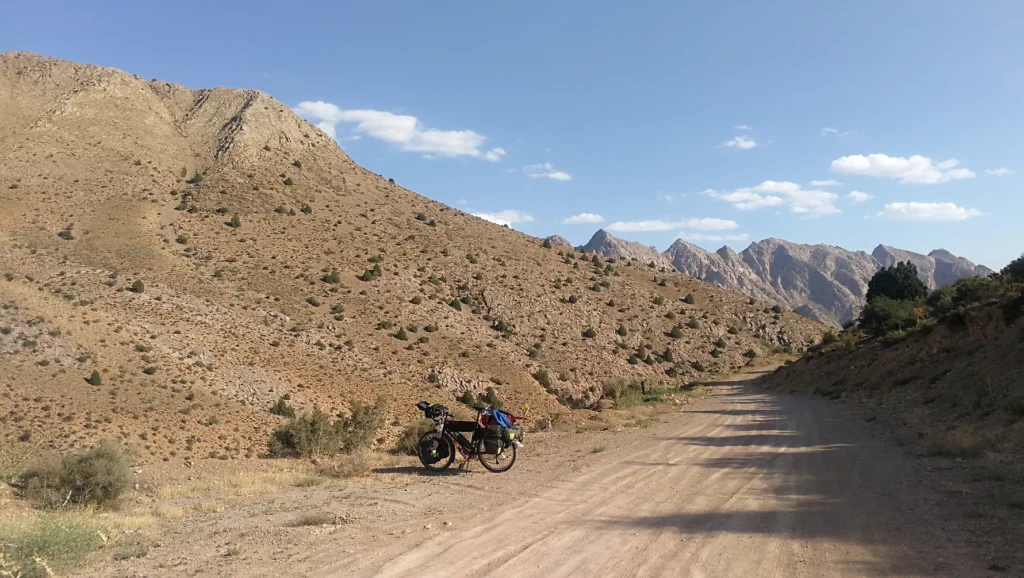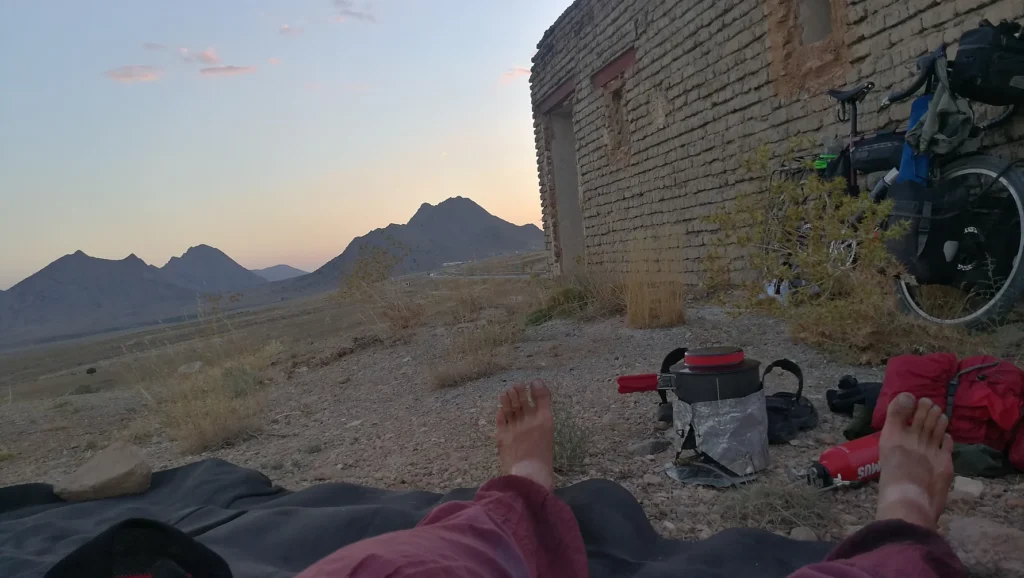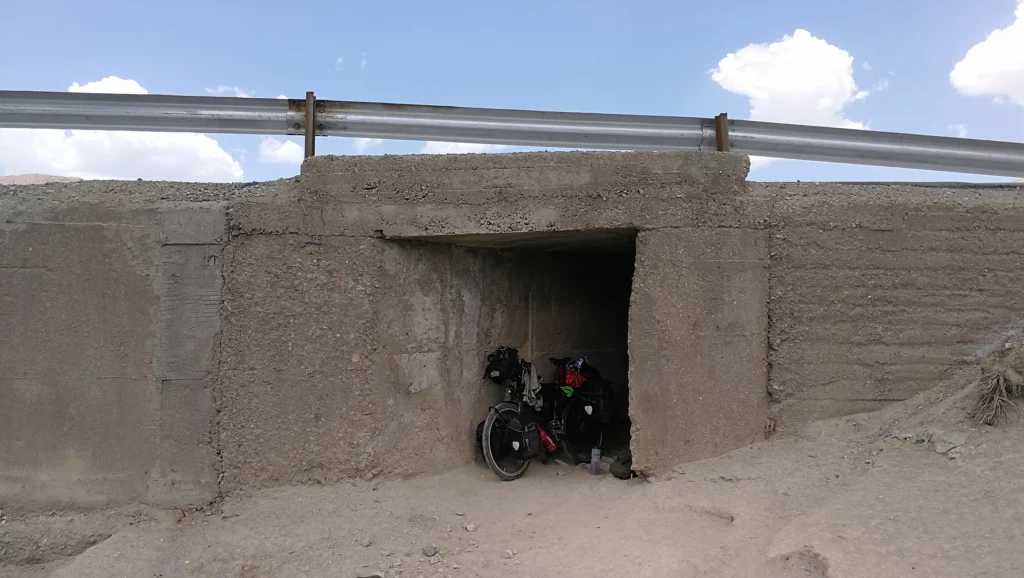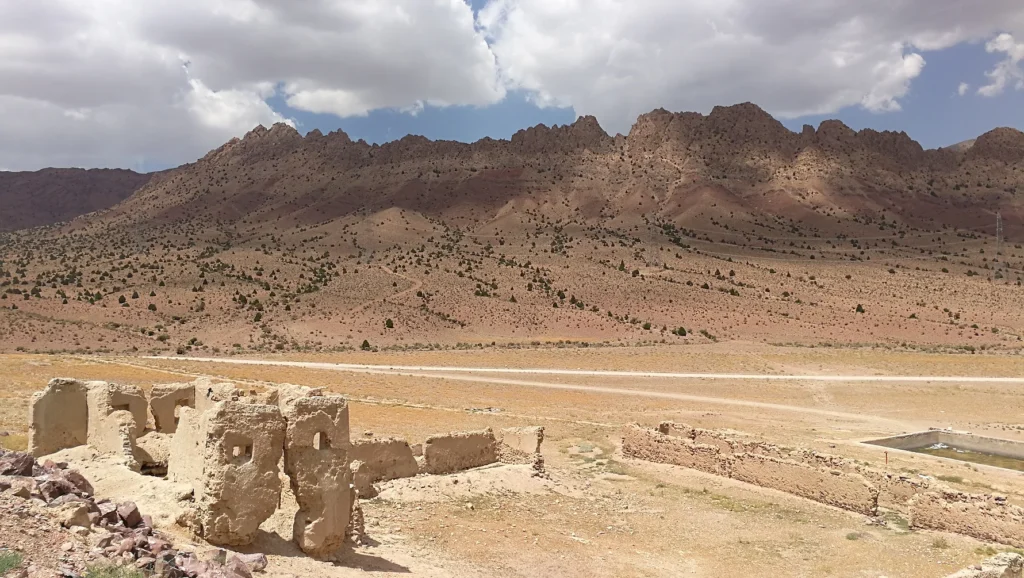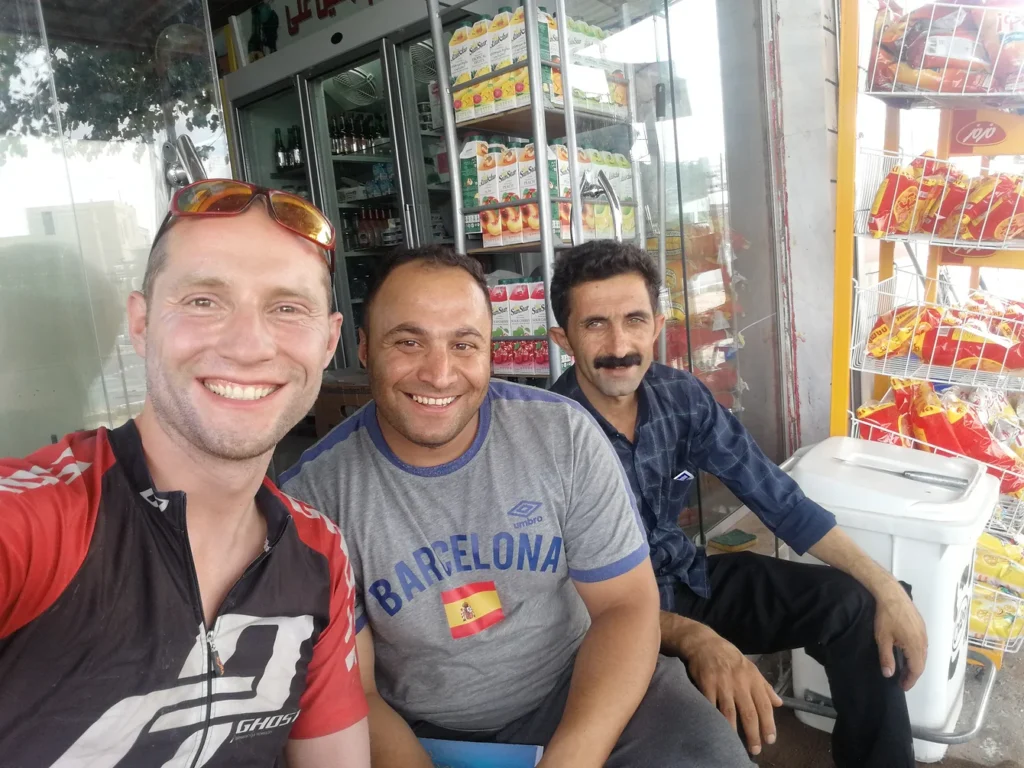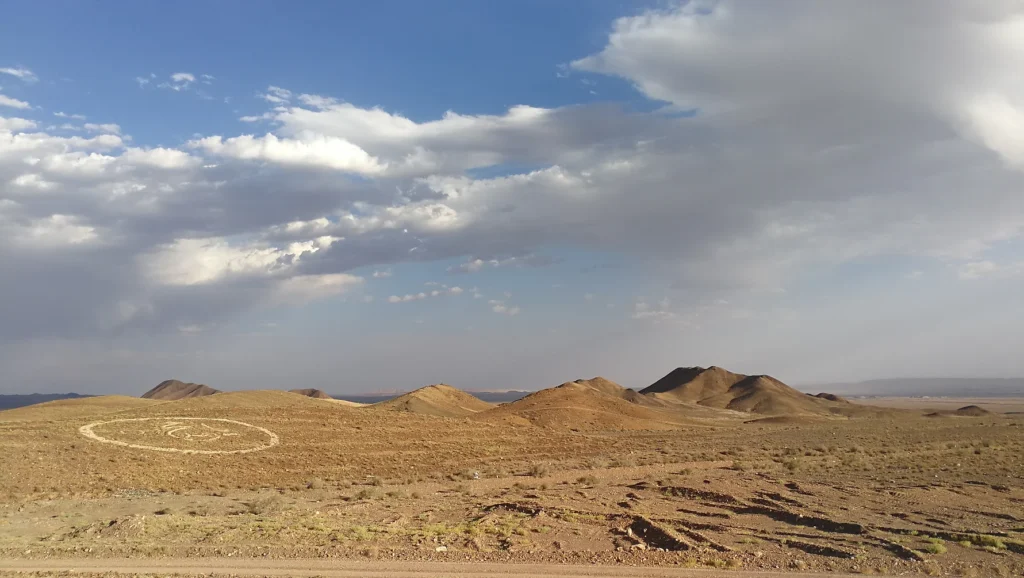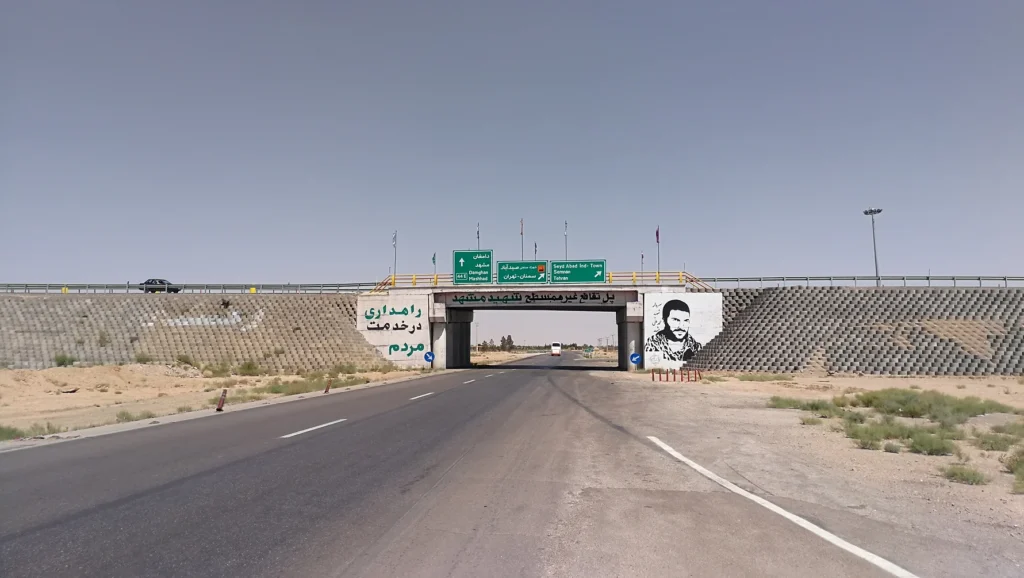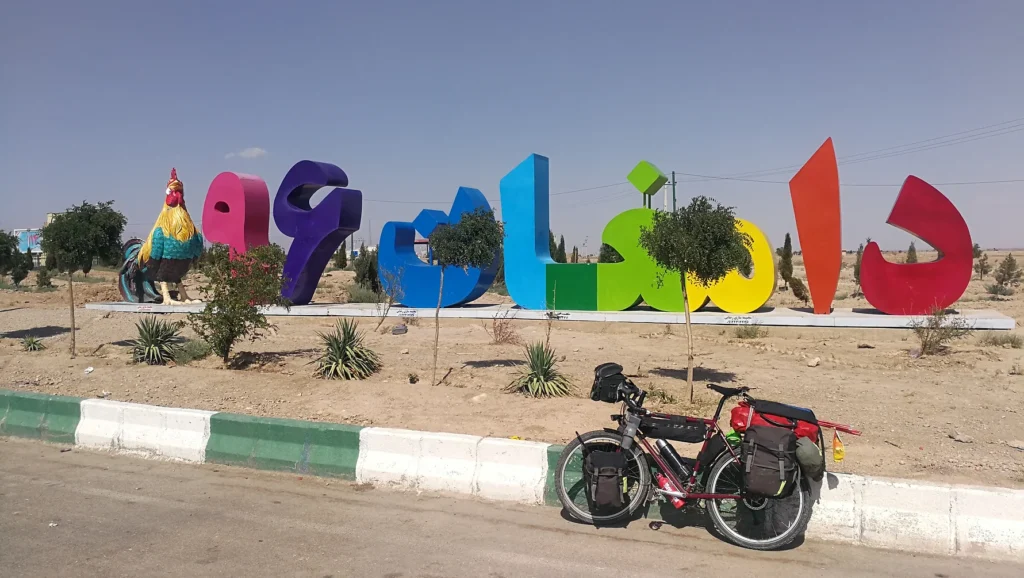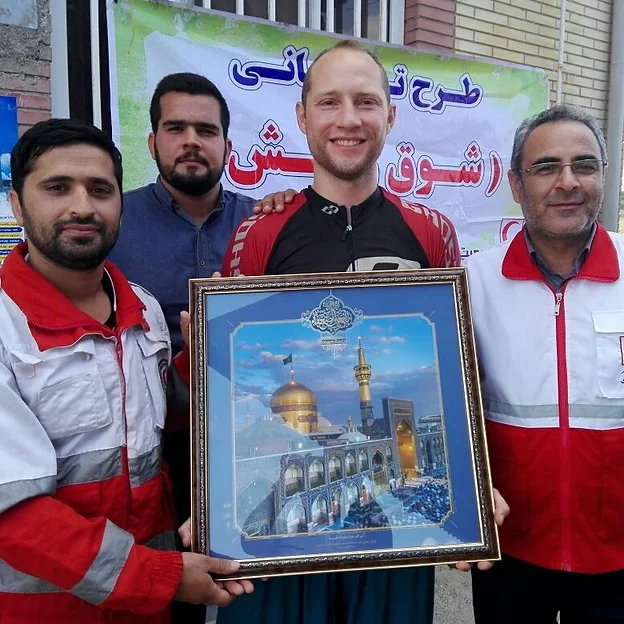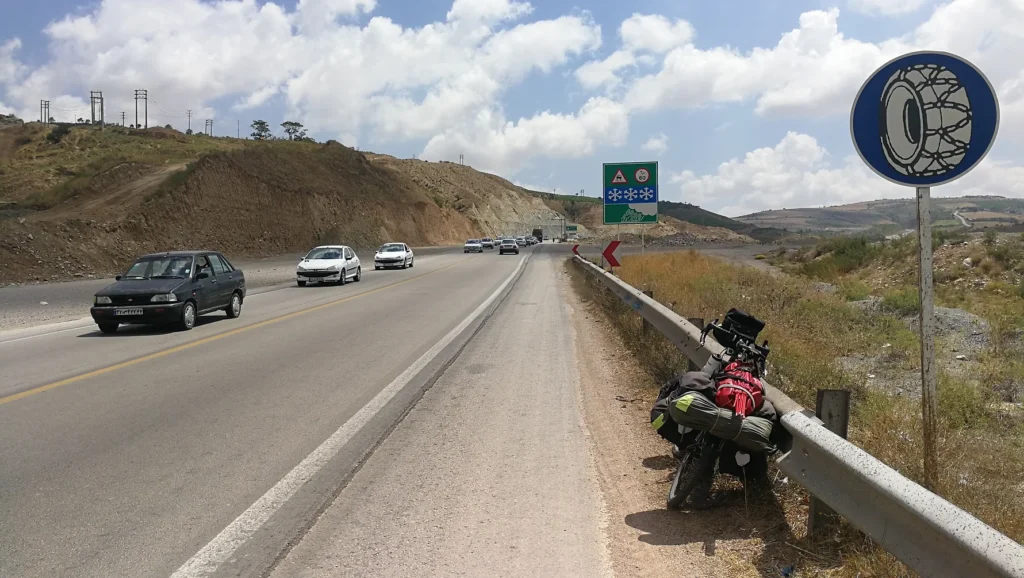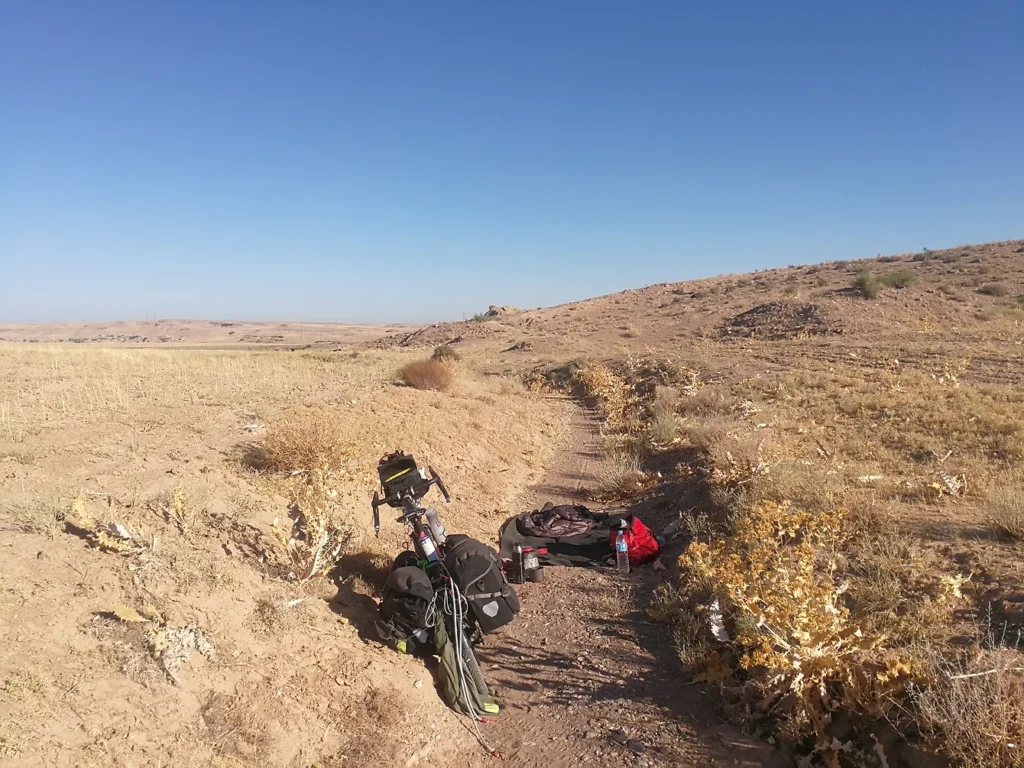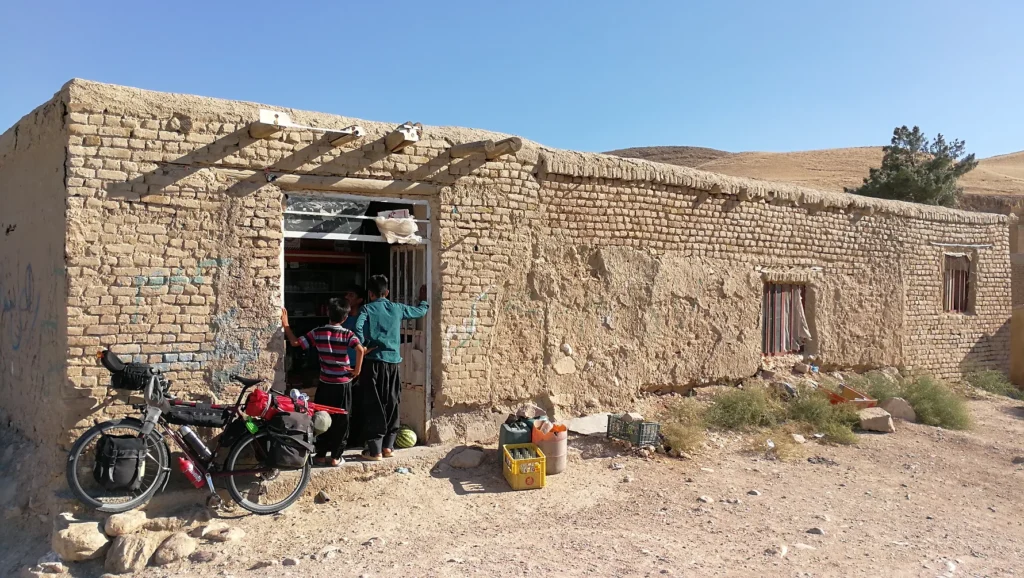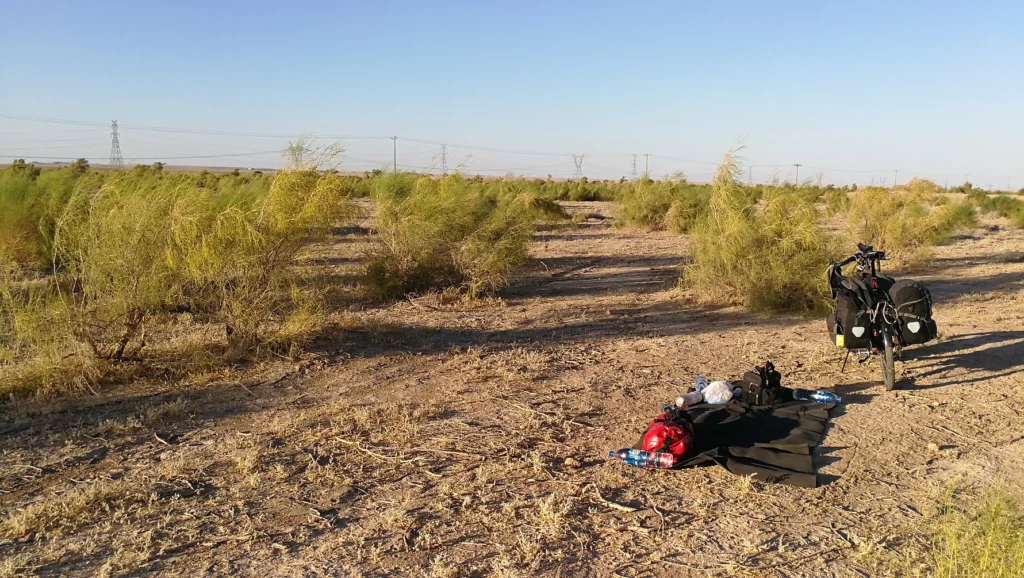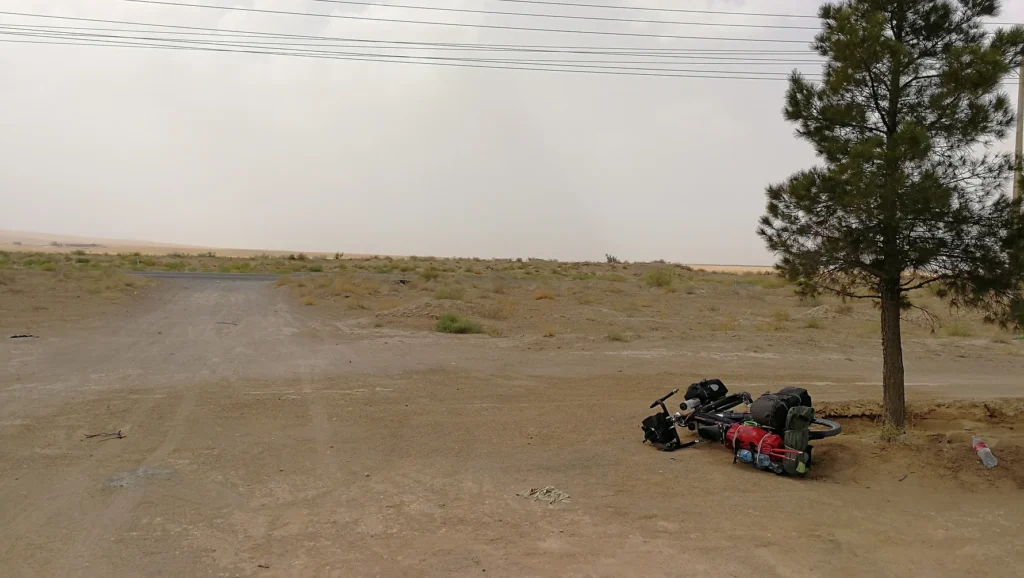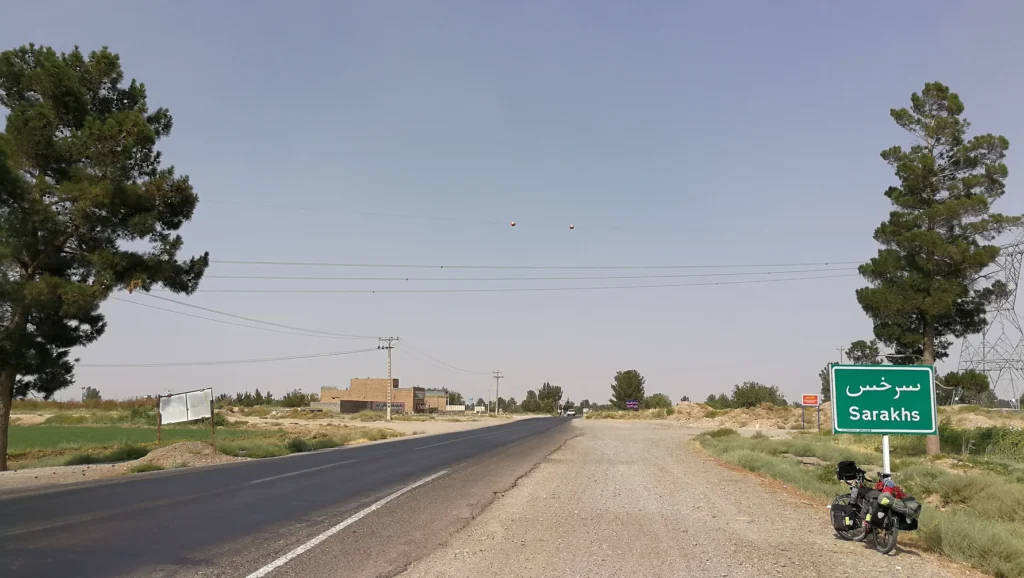Iran — Oneness
I reached the border crossing at 6:15 am and was through about two hours later.
Outside the border building I met a couple from Malaysia on a honeymoon round-the-world trip riding together on a Honda 150cc motorcycle. Definitely cool.
I cycled south into the mountains in complete silence – zero traffic, no people around. The beauty of the landscape and the vastness of the land touched me deeply. Was this a dream?
As I cycled up higher, the landscape open up and I could see the mountain chain I had decided to cross on my way to Tabriz. I felt respect but with enough water and food I was confident that this was doable.
Entering the unknown is always exciting, be it in our consciousness or on the road.
I wondered how much rain they get in this region and how much snow in winter. Do the farmers here use irrigation systems? Do they grow particularly heat-resistant crops?
Having marked some waypoints in my offline map in advance made navigation easy, also because some small mountain roads in this area are dead-ends.
Good road conditions, smooth navigation – the signs usually contain directions written in both Persian and Latin.
In Arzil I met two gentlemen at a small shop. Very friendly people, open and interested to chat.
Good thing I could buy more water at the shop as mountain cycling in the heat makes you drink a lot.
Two weeks ago Iran’s hottest temperature ever was recorded in Ahvaz in the southwest – according to official meteorological measurements 128.7°F/53.7°.
At 5pm the pass on the horizon was still 15 km away – these are big mountains to cycle in.
On the road I saw basically no traffic or people. Perhaps everyone was out working on the fields? But then again the harvest season seems already over.
I would estimate the agricultural fields here go up to about 2,000 meter elevation.
I met two shepherds who took care of a massive sheep herd without any dogs. I wondered where they went for the night with the herd, given that they were still high up with little daylight left.
The herd was spread out over more than a kilometer along the mountain flank – before I had never seen such a large herd in the wild without guarding dogs.
Perhaps these sheep simply work better together within the herd compared to other sheep?
I reached the pass at 2,400 meter just before sunset – my legs said it was time to cook a large dinner soon.
Soon after the pass I met two gentlemen who stopped to say a hi and take a selfie.
On the downhill I stopped to get water, then I started looking for a camp spot with a view.
Pretty strong wind in the evening so I searched a camp spot with wind cover. A small curious fox came by inspecting my tent – the first wild animal I saw in Iran.
Wow, what a day on the bike, what a density of new impressions. If you would cycle through Iran, which touring style you would choose?
Whether it’s cycling somewhere or living our life in general, the way we take our decisions is to follow what feels individually right for us – how else? Of course we consider external factors, but we consider them together with our related feelings before we choose our way forward.
In my view, all humans are existentially the same as we all live in the equal human condition. The details differ and we use our reality-bending force individually different but structurally seen, we all experience a life journey shaped by our cultivated attention stream in our consciousness.
In addition to living existentially similar lives, humans are connected in many further ways – for example, we exist in each other’s consciousness.
Does that somehow connect us all?
I got up early and continued the long downhill out of the mountains.
At first it felt strange not to be able to understand Persian until I realized that all is relative – Iran’s language and culture felt foreign to me but this would be the same experience for most people of the world coming to Germany.
There are languages written left-to-right in lines sorted from top-to-bottom – like Greek, Latin and English.
There are languages written right-to-left in lines sorted from top-to-bottom – like Persian, Hebrew and Arabic.
There are languages written in vertical columns top-to-bottom, with the columns being sorted right-to-left – like traditional Chinese and Japanese.
There are languages written in vertical columns top-to-bottom, with the columns being sorted left-to-right – like Mongolian and Uyghur.
There are examples of ancient languages which were written in vertical columns bottom-to-top, with the columns being sorted either left-to-right or right-to-left.
Some languages were sometimes written horizontally or vertically.
Some languages were written vertically but read horizontally.
Some languages turned the writing direction in each line.
Theories on language directionality argue that the materials used and the writing techniques were decisive.
Some say that languages written left-to-right avoided that the dominating right-handers writing with ink on papyrus smeared with their right hand over the text already written.
Some say that languages written right-to-left were started by people writing with a hammer and chisel on stone plates and for the dominating right-handers working right-to-left was easier.
Some say that languages written vertically was a natural choice when the writing was done on bamboo sticks.
That my mind was trained to read language “left-to-right in Latin letters” was just one of many ways a human mind can be trained to process language – and definitely not the only or the best way.
Thinking about language, I realized it wasn’t just that I almost didn’t know anything about the Persian language and culture. I basically knew very little about other languages and cultures and the world in general.
Breathing in, breathing out.
Persian, also called Farsi, is the official language of Iran and is also spoken in parts of Afghanistan and Tajikistan. In total, an estimated 110 million people speak Persian – placing it in the top 20 most commonly spoken languages of all 7,000 languages spoken worldwide today.
Do you think the language we speak matters for our consciousness experience?
Around noon I entered Tabriz at Azerbaijan Square in the north – an enormous square which is the largest in Iran. Moderate traffic but ok to cycle as Iranians seem to be pretty considerate drivers taking care of others.
Tabriz is a bustling city of 1.7 million inhabitants speaking Persian and Azeri Turkish – in the beginning I felt a bit overwhelmed by the number of people.
While I was cycling around downtown Tabriz, I met a couple who had also come from Germany by bike. They told me about a city park with good camping opportunities so I decided to join them.
On the way we stopped at the Blue Mosque of Tabriz build 500 years ago. Compared to the bustling street life outside, the mosque was so calm and peaceful that I felt as if I had entered another world for a moment.
The camping opportunity in the city park was a dream – own little huts to camp in, showers, no cost, and overall green and calm. This park is primarily used by Iranian families for picnics but foreigners are warmly welcome here too.
Perhaps the language we speak doesn’t really matter for our consciousness experience.
Sure, humanity has a necessity to communicate and language is a tool for that but the exact language we speak and “think in” seems largely irrelevant. Internally, the stuff that’s really going on deep inside our consciousness, the stuff we feel – that’s before and independent of any particular language, right?
People may speak Persian or German or any other of the 7,000 languages spoken today – our reality-bending force seems to be unaffected by our learned word-based language anyways. Like when we treat someone with compassion and respect, including ourself, it’s more about the real authentic feelings we create and our subsequent actions, not so much about the superficial words we form with our vocal cords and libs.
Have you ever said “I love you” to someone but you felt you didn’t really mean it?
Have you ever said “I hate you” in a playful-affectionate way to someone but you both knew that the opposite was true?
Perhaps neither the language we “think in”, nor the words we say, really matter for our reality-bending force … but rather our true, direct, and unfiltered feeling experience.
And the fact that we create each other reciprocally in our consciousness also doesn’t seem to be language-dependent – you exist in the consciousness of others whether they speak German, Persian, or Azeri Turkish.
I camped three nights in the park, relaxed, and explored the area. On my first day I discovered that I had somehow broken a spoke on my wheel – luckily Philip helped me fix it.
A broken spoke on the backwheel drivetrain side means you have to first remove the cassette. I didn’t have a tool for that but somehow Philip did the magic. A 3-crossed spoke is very tight to weave into a touring wheel like mine – we had to cut the old spoke to get it out.
When installing the new spoke you need a spoke tensioner which I also didn’t have as I had send mine home from Albania remembering that my bike shop in Berlin said “those wheels will not break”. We did the wheel truing with a cut cable binder measuring the wheel adjustment … respect and thanks to Philip who taught me this valuable bike mechanic trick.
This was a repair operation I should have practiced before leaving but at least I was smart enough to bring spare spokes.
A chain replacement and the bike was ready for the road again.
On my second day I explored some markets of Tabriz – if you walk around here life looks overall similar to Germany.
In Tabriz I also did some onward route and visa scenario planning. Iran gives you a 30-day tourist visa and I would need a couple of days in Tehran to get my Uzbekistan visa for which I had done preparatory steps, before being able to apply for a Turkmenistan transit visa.
Iran is a large country to cross and with the distances and limited visa days in mind, I decided to ramp up my average kilometers/day cycled in the days ahead.
Gradual road climb southeast of Tabriz to 2,100 meter elevation. The nearby Sahand is a dormant volcano massif rising up to 3,700 meter elevation – it’s a nature conservation area home to animals like brown bear, wolf, leopard, and the Armenian mouflon.
Pretty hot day but relaxed as there were plenty water and flood supply options along the road.
Where possible I cycled on smaller roads than the highway. On the smaller roads a large part of the traffic were trucks.
In Bostanabad I stopped for a plate of rice in a restaurant. Friendly locals, welcoming atmosphere.
There was much less traffic after Bostanabad as there the road splits into north, south, and east connections into which the traffic distributes.
The more east and away from Tabriz I cycled, the less traffic was on the road until most of the time I was alone. As usual in the countryside, the locals were more interested to chat compared to large cities.
The roadsigns made it easy to learn the Persian numbers. Tehran was ۵۱۵ km away – so “5” is the flipped heart “۵”.
What’s special in Iran are the colors and the light. Things often feel natural here, without much visual pollution.
Near Gug Daraq I met two locals on a bike tour. People here are friendly and welcoming – this was my experience without exception during my whole time in Iran.
Today I experienced cycling in flow. I just kept rolling on and on through mountains and villages and canyons, and in the evening I realized I had cycled 180 km since Tabriz.
Time to cook a large dinner. I pitched camp next to railway tracks but there was only one train all night so it didn’t matter.
How is the reality-bending force inside your consciousness connected to the reality-bending force of other humans?
The way to find this out is not an “analytical” way of words and language describing our connection – it’s rather an “experiencing” way of direct and unfiltered feeling.
The force connection between us exists all the time and everywhere and the less we distract ourselves with words, the clearer we experience it in our consciousness.
So why write or read or think any words at all?
Words have a functional role in our existence as our self-conceptualizing (“Who I am?”, “How does the world around me function?” …) is part of our reality and helps us navigate it.
We all grow up naturally conceptualizing stuff in language and we should probably therefore first accept all our concepts and mental maps with compassion as they are an essential part of our journey.
But over the course of our life we seem to go through some sort of consciousness evolvement process. Through the experiences we make, through the way we live our life, through the way we cultivate consciousness attention, we all seem to unfold our potential to be less cognition- and more feeling-oriented. I believe this happens naturally to some degree but we can accelerate this shift by practicing things like self-compassion, self-trust, and letting go.
What’s your perception of the human consciousness development? Your perspective is as valid as mine.
In my view, the force connection between us is something everybody can experience in every life situation. And I am convinced that we can all strengthen our ability to feel it – not so much by following a linear process … it’s more some kind of deep change in the general way we exist.
Given that it’s not something that can directly be captured with language, thinking is probably overrated. This is what I find the greatest shortcoming of the entire written body of human knowledge – texts usually don’t reflect on their inherent severe limitation of being language-based.
The force connection between us cannot be felt as long as there is too much conceptualizing text blocking our direct feeling experience. This includes these words you are reading right now – let them go.
If this world view is true, if words and language are in our way towards something like an expanded consciousness experience, what should we do?
Perhaps looking at our life in phases is beneficial. Perhaps it’s healthy to first develop an awareness that we constantly and naturally develop our consciousness. Perhaps like that we cultivate a growth mindset allowing us to overcome rigid conceptualizations of “I am” … who knows, everybody is unique.
I think it’s ok when we stop trying to control our experience. Our reality will keep existing just fine if we let our concepts about ourself and the world go.
If you want you can always try it out and see how it feels when you practice it for a while – in any case, you will probably find something new inside yourself.
Making our consciousness expansion stable, shifting the boundaries of our perceived existence permanently, using our reality-bending force in full awareness of our force connection to other people – I think everyone can do this.
Perhaps we can start by accepting our thoughts before letting them go into something larger – something like an expanded consciousness experience in which we co-create our reality more clearly, more calmly, more awake, more passively observing but also more actively shaping, more free.
Do you want to feel deeper, look further, and experience more of your reality-bending force in connection with others?
We all are the force, and we are the force together.
While I was eating breakfast a white dog came down from the mountains. He first inspected my tent cautiously and then waited in a tunnel I had to pass to get back to the road. He didn’t seem territorial at all, perhaps he was just curious.
I followed the Qezel Ozqn river south which was dry at this time of the year but judging from the riverbed can be wild in times of rain and snow melt.
I stopped at a bridge from the 8th century which was well maintained except for the middle part.
I followed the river further south until the mountains disappeared and the land widened. On this stretch most settlements near the road seemed abandoned but I also saw farming activities which I believe were watermelon cultivation.
Given the still moderate temperatures and limited traffic, I decided to keep up the pace before the afternoon heat.
You can take a train from Tabriz to Tehran if you are short on visa days – but according to my calculations and assumptions on required days to organize my Uzbekistan and Turkmenistan visa, my Iran visa should just be long enough to cross Iran by bike while visiting some areas I was interested in.
Around 11:30am it started to become hot – time for a cold drink in the shade. Some kilometers ago I had passed a tiny village “Aras” with probably less than 100 inhabitants and zero visible industry, and now I was served an “Aras” Cola. Could this really be a local cola or was there another explanation? I knew nothing.
Around noon I reached the Zanjan Rood river and followed it east. A boy at the roadside waved to stop me and gave me a melon as a gift – just the right size to eat during another afternoon cooling stop under a bridge.
Some kilometers outside Zanjan, a medium-sized city, I checked my map. Should I camp before the city, cross it before dark and camp after the city, or try something else?
I checked a biketourer network app and was surprised that plenty of people in Zanjan offered to host cycle tourers. The first person I contacted directly said “ok sure I pick you up in 1 hour at the roundabout”, and so I stayed with a very cool Iranian family for the night – their hospitality and trust was truly amazing.
Perhaps the whole oneness thing is easy. Perhaps we can experience it whenever we give a helping hand to others.
The Dalai Lama says our human world community has become a single multi-cultural and multi-religious entity. He has published extensively on ethics and religious tolerance, pointing out that our differences are superficial and that we can overcome them as a global community:
“I think [for] all human beings, our life begins with our mother’s affection, that is same. So then later, different philosophy, different country, different religion. I think some way we little neglect about oneness of 7 to 8 billion human beings … we are born the same way. We should keep that experience and have less emphasis on my nation, their nation.”
Given the reality-bending force we all possess in our consciousness – our lifelong consciousness attention stream with which we shape our reality based on what feels right: what would happen if we give more attention in our consciousness to feeling humanity’s oneness?
Seriously, what would?
I left Zanjan early to cover some distance before the midday heat. I continued cycling southeast towards Abhar and was surprised about the traffic given that it was a Friday which is the weekend in Iran.
Cycling fast in Iran is easy – the tarmac is overall in a good condition, bottled water is available regularly, and people drive considerate. Sure I prefer cycling in nature but blending into the traffic flow here was smooth.
I past Takestan which in Persian means “vineyard” – it’s one of the largest grape and grain production areas in Iran.
Many friendly roadside encounters, watermelon invitations, and warm smiles. Be it in Germany, Iran, or the rest of the world, structurally seen people are kind of the same when you look into their eyes and take time to listen.
What is the relationship between humanity’s oneness and our individual reality-bending force?
According to thinkers across cultures and time, oneness is much more than a philosophical concept – it’s a power source.
It’s secondary whether our embedding in humanity is viewed globally or locally: whenever we choose to give consciousness attention to any level of our human community, we get something in return – something powerful, something deep.
For example, throughout his teachings the Buddhist monk Thích Nhất Hạnh emphasized the power of a “sangha” (community):
“You need a sangha; you need a brother or sister, or friend to remind you what you already know. The Dharma is in you, but it needs to be watered in order to manifest and become a reality (…).
I’ve been a monk for 65 years, and what I have found is that there is no religion, no philosophy, no ideology higher than brotherhood and sisterhood. Not even Buddhism.
In society, much of our suffering comes from feeling disconnected from one another. Being with the sangha can heal these feelings of isolation and separation.”
Feeling connected, healing together – isn’t this what we all want deep inside, dear reader? I definitely do.
I’m unsure if physical vicinity or any degree of group formalism is required to access the natural force of human community. Such things may help, but I believe human brotherhood and sisterhood can be experienced even when we live in a cave when we focus our attention on others with unconditional love.
The other way round, formally living in a community but with an empty heart for others probably leaves us without such a power access – no matter which “words” we think and say.
How does it feel for you knowing that your embedding in the human community gives you power?
I cycled in flow long into the evening feeling happy, feeling alive, feeling free. After 150 km cycling since leaving Zanjan this morning, I left the road to find a campspot in the countryside.
In the countryside in Iran it’s easy to find a calm campspot. And with a six-pack of 1.5 liter water bottles I could also make a good camp shower and go into my sleeping bag fresh.
Oneness can be understood in different ways.
We can speak of “oneness of humanity” meaning that all 8 billion individual humans living on earth today form a collective, a global community.
Or we can speak of “oneness as a consciousness state” in which we feel and see and perhaps comprise everything – when our consciousness has expanded and transcended to an ultimate degree.
As long as our consciousness is in a dualistic and object-oriented mode of conceptualizing “myself” vs. “the others”, we can think and speak and read about “oneness of humanity” and “oneness as a consciousness state” with any conceptual interpretation – in both cases we remain a theorist thinking about different states in which a consciousness may exist, but we don’t develop forward towards something like an “all-in-one transcended consciousness”.
Have you ever stood at a pool of water and you “thought about” jumping into the water?
We don’t become transcended just by “thinking about transcendence” – we have to do something, let the experience arise, find a deep balance between being a passive observer while taking our unique self along the ride – we have to become a practitioner.
Do you think it’s beneficial for a human consciousness to think about expanding into an all-in-one consciousness? I think everybody can do it in every life situation and who knows … it could be fun.
Breathing in, breathing out.
I slept long and took my time for breakfast. Tehran was 190 km away and I wanted to be relaxed and strong on the bike while trying to reach it by this evening – sometimes, going slow is fast.

I rejoined the highway at Qazvin – from here Tehran lay one straight line ahead in the southeast.
After Qazin I switched to the smaller road 32 which runs parallel to the highway. Also pretty good tarmac to cycle and more things to be seen.
From Karaj into Tehran center the traffic was packed for 50 km.
In the evening I checked into a hostel in downtown Tehran after having cycled 650 kilometer over the last 4 days.
When someone holds you, when you feel safe and at home in a community, when you feel loved and accepted as you are – are you alone?
Ideas around oneness of humanity and transcended consciousness states have a common element which is the “us”. Yes we all are an individual instance of the reality-bending force and yes we are all individually powerful – but we all exist existentially woven together.
I believe it’s beneficial to think about these things. I believe that words reminding us of our oneness can be impulses to bend our joint reality forward into a direction we like, in a way that feels good – and I believe words about oneness can also help us to make decisions in our daily life we are proud of.
This is of course something we all already know and feel inside … I guess sometimes our awareness of it is just a little bit hidden by all the things and layers floating around our consciousness.
The Persian poet Saadi Shirazi, born around the year 1210, wrote a poem called “Bani Adam” (meaning “children of Adam”, or “human beings”) whose first lines are written on an Iranian banknote:

The poem continues:
“If one member is afflicted with pain,
Other members uneasy will remain.
If you’ve no sympathy for human pain,
The name of human you cannot retain.”
What Saadi expressed 800 years ago is the same the Dalai Lama expresses today and it’s the same countless others have expressed since the beginning of mankind: we are all existentially woven together through human compassion.
Practicing and experiencing oneness is not about a philosophical concept, it’s something warm and alive – it’s something we all fill with life in our daily lives through the way we live, through the decisions we make, embedded in the network of humanity. Oneness is something you and I can practice and experience today.
There are further dimensions of oneness, such as humanity’s oneness with nature. Humans don’t live “in” or “next to” nature but rather, as biological beings, we are a part of nature. We reproduce, we get born, we breath and blood is pumping through our veins, we eat plants grown by the interplay of fertile soil, water, and the sun – and one day we die, stop breathing, and our biological bodies decompose.
Close your eyes and imagine for a moment that we use our joint reality-bending force to give more attention to our biological oneness with nature – how would the resulting “reality unfolding direction” feel for you?
I think we all can do it, changing the world … it starts with the simple choice of our consciousness attention and everything else follows.
I believe that no matter which challenges we face as humanity – climate change, biodiversity loss, pandemics, wars, terrorism, poverty, hunger – we are strong and smart and compassionate enough to work out solutions as a global community. Crisis are always opportunities to grow – for you, for me, for mankind.
Of course some things will always be in the way, it’s what makes life such an interesting game to play, right? If I had to pick one key hurdle for humanity it would be “exaggerated nationalism”. Given that in the 21st century we face interconnected global problems across borders – wouldn’t it be our benefit to move more from nationalism towards international collaboration?
I don’t mean this as a utopian dream, but rather pragmatic and realistic. Like the “United in diversity” principle of the EU, or the plurality-based work of the United Nations … everything is possible if we choose so in our consciousness.
In my view, we can keep our uniqueness on the level of an individual and local community member up to regional, national and continental traditions while collaborating intelligently to get the best from both worlds, to get the best from individuality and collaboration at the same time.
And when we trust each other more and collaborate more based on human compassion, it’s going to produce better solutions to our common challenges and we are going to feel better too.
I believe in you dear reader – don’t forget that you have the force inside yourself to change the world.
I got a visa for Uzbekistan, applied for a transit visa for Turkmenistan, and searched the endless Tehran markets until I found some important items probably hard to get in the next countries: a spare tire, spare chains, and good sunscreen.
When you cycle overland from Europe to East Asia on a route south of the Caspian Sea, at some point you will be in Iran thinking about onward route options.
Cycling through Afghanistan is probably very tricky. Taking a ferry from Iran to one of the Gulf countries and then travelling on a cargo boat to East Asia is perhaps possible, but probably expensive and tricky. Cycling from Iran into Pakistan is perhaps doable but dangerous – and you would miss some great mountains on northern routes such as the Pamir mountains in Tajikistan.
So if you don’t want to fly and you want to cycle a route through Central Asia you basically need a visa for Turkmenistan. In order to be in the right area in the right time window (Turkmenistan and Uzbekistan visa are date-specific), I applied for a 5-day Turkmenistan transit visa in Tehran to be possibly picked up in Mashhad in the northeast of Iran two weeks later. With a 30-day Iran-visa this was a tightly knit plan but cyclists have done it before so I stayed positive.
With this plan the next question was which route to cycle. I went for a mix of mountains and desert – from maps it’s not really possible to anticipate cycling condition but as long as you bring enough water what can go wrong?
Do you know the Cheshire Cat from Alice in Wonderland? For Alice who fell down the rabbit hole the cat is a guiding spirit – perhaps on our consciousness explorations we can sometimes use one too.
I asked her and she said: “Cycle to Mashhad through the desert!”.
Ok!
In the morning I cycled out of Tehran towards the east. After the 4-day break I needed some time to get back into my cycling rhythm – it felt good to be back on the road.
60 km east of Tehran I passed through Damavand, named after nearby Mount Damavand – a 5,600 meter tall dormant volcano
A decent uphill in the afternoon, some tunnel, heat. In Tehran I had missed the simplicity and freedom of being alone in nature – above all inhaling fresh air in my lungs.
In the evening I reached a pass and the land opened up into an ocean of gently rolling hills until the horizon. It somehow feels good to know that large parts of our earth are unsettled.
Sometimes people in Iran just stop to say a friendly hello and take a picture. They live in a country so rich in culture and natural treasures – they can be proud of what they have.

I pitched camp near the highway and slept on the ground without a tent – I felt free.
How does it feel when you let your consciousness expand?
Perhaps our consciousness is always expanding and we are just not aware of it because the change happens slowly.
Given that consciousness expansion is something that we let happen and not something that we do, I believe it’s generally a process that is light and easy from the beginning. Why force something that happens automatically?
Our experience may initially be dominated by temporary effects overshadowing the long-term feeling that is growing slowly but unstoppably inside us when we practice consciousness awareness. For example, the full spectrum of possible emotional blockades may pop up asking us to be felt and integrated.
The good news is that we really don’t have to do the work – some of the hardest hurdles inside us solve themselves when we let it happen. And I think we all have the natural strength to do so – you can always tune your consciousness attention which is all it takes.
Leaving our old concepts of self behind towards a oneness consciousness beyond a dualistic “inside me” and “outside me” is a lifelong process – I believe everyone makes this journey and only the details and our individual awareness of this process differ.
Perhaps we can focus on the space in between our feelings and thoughts when we practice letting go – feel into the emptiness for a while and see what you experience.
In the morning I packed up camp and started cycling early to cover some distance before the heat.
I left the highway leading towards the Caspian Sea and turned southeast – time to see the desert. I cycled through a narrow gorge and found it on the other side.
Leaving the highway meant leaving the traffic behind. The landscape here touched me – I believe sometimes we feel the most when we are surrounded by emptiness.
At 13pm I took cover from the mid-day heat near Gur Sefid and took a nap in some kind of canal. Nobody around – great conditions to just exist and feel into emptiness.
After Gur Sefid I crossed from Tehran province into Semnan province and I directly felt a strong sympathy for the people of this region – to live in the desert takes courage and grit.
From the mountains down to Semnan city it’s a constant downhill for 50 km – this was a fascinating cycling experience in a scenery I will never forget.
Do you think the environment we live in changes our consciousness?
Perhaps people living in the desert can feel more into the space in between things … the empty space that exists between and behind all elements in our consciousness.
But perhaps having less distractions is secondary as the whole physical reality is not influencing this space at all. Who knows, perhaps people living at the busiest intersection of Tokyo are really good in feeling into emptiness?
Or perhaps the place you are living in right now, dear reader, is particularly well suited to practice and experience consciousness expansion. You tell me!
There is a difference between jumping into a pool of water and jumping into emptiness in our consciousness. When you muster the courage to jump into the pool, you take a breath and bend your knees and then when you jump forward you reach the pool in 1 second. In contrast, when you jump into emptiness in your consciousness, the reality feedback is much slower and usually much more subtle.
Are we all jumping into emptiness in our consciousness all the time?
Perhaps love is somehow the base grid of reality, the thing connecting everything and us all. Perhaps this is what we first remotely sense and later become when we jump and let our consciousness expand.
The people who live here in the desert may already know.
Breathing in, breathing out.
Breathing in, breathing out.
Existing is kind of fun. Like a movie in the cinema that never ends, a movie that we can shape with our reality-bending force – a movie we can directly feel.
Pretty hot day despite the clouds. I wondered how much rain they get here in July.
Desert cycling is really not that difficult. But you have to take a lot of water and read the map well – making plausible assumptions where you will likely find water again, and bringing a reserve for headwind situations, bike problems etc.
Semnan in 35 km should be a reliable water-restocking point ahead.
The plains welcomed me with gusty winds – I first thought there was a fire but it was dust.
In Semnan I got 11 liter of water – the next certain water restocking point was a fuel station 50 km uphill ahead which was too far for today, so I took enough water until roughly tomorrow noon.
When you look into the eyes of people in Iran you see something good – you see that they use their reality-bending force wisely.
Long uphill into the evening, no more wind, peaceful landscape. Have you ever tried letting your feeling perception expand into the clouds?
In the last sunlight I saw a canyon near the road and decided to sleep in it – this place looked inviting from the beginning.
Like yesterday I slept another night on the ground without a tent. I watched the stars without asking myself questions, just feeling free, just becoming one with the canyon and the night sky.
Everything that exists seems to be woven through with something, something deeper, something that feels a bit mysterious but also familiar. I believe everyone practicing paying attention to it can perceive it.
Perhaps we perceive it more with our belly, kind of non-cognitive, not with a directionality of our eyes looking around.
Perhaps our cognitive mind trained to see the world in 4‑dimensional space-time can’t perceive it before we practice letting go of our old reality concepts.
Is there a place where we all come from, a place where we all go?
Is there a place where everything is one?
I am convinced that there are things we can’t directly perceive cognitively which are there – as countless people have expressed in different metaphors since the beginning of humanity.
What is your version?
Whatever your individual metaphor for the things beyond our human cognition – atheistic, spiritual, or anything in between – I hope that you succeed in building a life around your reality interpretation that feels authentic and good for you.
I believe that complicated theories of things beyond our cognition can be in the way to fully experience them. And I think you are already perfectly capable to do self-exploration around the reality-bending force in your consciousness – I don’t think that we need anyone to give us an explanation or advice, even so sometimes some ideas of others resonate in us.
In my subjective experience, paying attention to the “empty space between my feelings and thoughts” has been a constructive metaphor to practice letting go in my consciousness – but this doesn’t mean that it works for you or anybody else.
I believe it’s anyways more about the way we pay attention with than the objects we pay attention to that matters … something like our base attitude or base motivation for existing.
Good morning – another friendly desert encounter as soon as a rejoined the highway.
On a gas station I met some cyclists and their support crew. I think they did a longer desert cycling event as the support crew had set up a base with carpets to which I got invited to rest and drink tea.
I left the gas station refreshed and with full water bottles. Also today I took a big water reserve as there was a strong headwind which means cycling is tough and you need much longer until the next water supply point.

In this stretch there were more water supply options than I had assumed. What I learned on the tour was that in reality there is usually more infrastructure and life than shown on maps – sometimes route-planning is therefore best done by switching between satellite image and normal map views as on the satellite images you also see unmarked things.

The desert is a really good listener – she doesn’t get tired, she doesn’t judge, she gives your consciousness space to expand.
As a consciousness explorer perhaps it’s good to spent time in an environment where we can’t understand the language – it makes one feel a bit lost, a bit vulnerable. That’s great as this experience holds up a mirror to our consciousness and shows us what we usually focus on.
It’s easy to look at the world from a familiar bubble … but it’s also easy to look at the world with a new perspective – everything we find familiar was new to us at some point, be it in the physical reality or in our consciousness.
آیا روی زبان تمرکز می کنید؟ فقط روی رنگ حروف تمرکز کنید…
In Damghan I met a group of local cyclists on the street. Their coach Hamed invited me to stay at his home and they showed me around town, including a night trip to a spring in the desert. Very cool and friendly people – and strong race cyclists too.
Do you think it matters how we treat each other?
Even when we don’t speak the same language, which is not really the case in Iran as most people here speak good English, we share the universal language of a smile.
Perhaps the place where we all come from and where we all go is a place where we treat each other with respect and kindness – a place where we value human connection, a place where we are brave enough to make strangers to friends.
I have the impression that this thing that’s woven through everything is something that we all naturally understand – something that expresses itself more through our actions than words.
Strong headwind all day, strenuous cycling, slow progress.
In the evening I was happy to find wind cover behind some earth piles.
I think on our consciousness journey there is one thing that is central as a starting point – yourself.
We can talk about oneness ideas forever but without an integration of your individual emotional biography this will remain philosophical theory.
The good news is that oneness and our emotions go hand in hand. When we meditate into oneness, for example by paying attention to the space between our feelings and thoughts, we automatically make room for emotional integration. And the other way round, when we meditate into emotional integration we pave the way to see further in our consciousness.
Which of the two sides should we focus on?
I don’t think a general statement is possible here other than it’s an individual path and everyone probably benefits from giving some consciousness attention to both – oneness, and our individual life biography with all the stories it has written on our soul.
Does it make sense to talk about techniques?
Towards a oneness conscious state, perhaps practicing self-trust and compassion and letting go are useful as interim things to give attention to – but generally I would say overcoming words and attachments to cognitive concepts is key.
Towards emotional integration, countless recipes and techniques have been articulated – I’m pretty sure you already know everything you need and you just need to execute. Just remember to truly feel your emotions, don’t over-analyze them cognitively.
It’s like with sports. You can read all books about sports but in the end you have to pick running or rowing or cycling and you have to repeatedly practice to actually get sporty and healthy if that’s your goal.
Should your goal be developing a oneness consciousness, emotional integration, or strengthening your ability to use your reality-bending force more consciously – and I fully respect if none of that is your goal – but should anything like that be your goal, then a key ingredient you probably need is honesty.
I’m just a cyclist but in my perception it’s tempting for humans to be philosophers – isn’t it entertaining to chat about existential philosophy at the dinner table?
And philosophy is just knowledge “out there” and we can only benefit from looking at it, right?
But if a oneness consciousness is a perception of everything, it also comprises everything in life that is painful: every time we made a mistake, every time we got hurt – we need to be honest about it and integrate it in our consciousness or oneness will remain an abstract idea. The same goes for joy and happiness and being proud of ourself – we need to be honest about it too and integrate it equally to develop towards oneness.
Oneness consciousness logically follows being whole, having accepted and felt all parts of us.
Due to the strong headwind I decided in Shahroud to change my route and cycle north into the mountains.

This route passed through Khar Turan National Park – a massive protected area home to endangered species like the Persian Onager (a relative of the Zebra) and the Asiatic Cheetah.
In the 2014 soccer world cup the Iranian football team played in jerseys displaying a Cheetah to promote worldwide environmental protection. While the Asian Cheetah, the world’s fastest animal, used to live in habitats across India and central Asia, as of January 2022 there are only 12 wild Asian Cheetahs left in total – nine males and three females, living in Khar Turan National Park.
How does it make you feel that the Asian Cheetah is almost extinct? To me it hurts.
Stormy pass separating the Semnan and Golestan province. From the pass it was 50 km downhill which I raced hard – I felt like speeding after the past headwind days.
The downhill from the pass at 2,000 meter elevation down to Azadshar at sea level brought another climate zone – given the closeness to the Caspian Sea, north of the Elburz Mountain chain it’s hot and humid.
In the last part of the downhill I cycled into a thunderstorm. At its climax I cycled for 20 minutes on a narrow road with streams of mud and stones flowing over the road from the mountain flank on the right. Here I felt unsafe but given that some stones rolling over the street were football size I decided to cycle on to get out of the mudslide risk area.

In the evening the weather cleared up and I cycled into the night northeast. Independent of the previous thunderstorm, I asked at an Iranian Red Crescent site if I could sleep there as I had read that sometimes they let cyclist sleep on their premises – they warmly welcomed me with a shower opportunity, food and a bed.
These gentlemen do 5-day shifts (24h standby) and mostly wait, so they are happy to host a cyclist sharing some adventure stories from the road. At night reality came back as they went out to a car crash in which one person died.
I think on our consciousness journey there is one thing that is central to focus on less over time – yourself.
When we focus on our individual conflicts and struggles and traumas and blockades, just like when we focus on our individual happiness and successes and wishes and emotional growth – when we focus on ourself, even on things like our individual waking up and consciousness expansion, whatever that means – then we don’t focus on others.
In my view, it’s a fundamental difference if we are “just cognitively aware” of the existence of other humans, or if we really love our human brothers and sisters – not just sporadically but somewhat regularly, long-term, and with substance.
The direction of our consciousness attention is more complex than a simplified polarity between “myself” and “others” … but then again this division is pragmatic in our daily life.
Oneness consciousness requires balanced attention.
In the morning when I was just about to start cycling, an Imam came by for a Red Crescent youth recruitment event. He gave a speech, distributed traditional sweets, and as far as I understood encouraged local teenagers to join the Iranian Red Crescent.
The Imam had brought a beautiful framed picture of the Imam Reza shrine in Mashhad for the Red Crescent employees but gave it to me as a gift. I kindly accepted and later passed on the picture as a present to my Red Crecent hosts to thank them for their warm-hearted hospitality.
I cycled east into Golestan National Park – a large nature protection area with dense forests home to leopards, wolfs, brown bears, deer, wild pigs, and gazelles.
Golestan is Iran’s oldest national park which I really wanted to see and in order to see it properly, I had chosen a route crossing the Elburz Mountain chain yesterday, and again today in the reverse direction.
Like yesterday I cycled into a thunderstorm in the afternoon but found good cover under some trees.
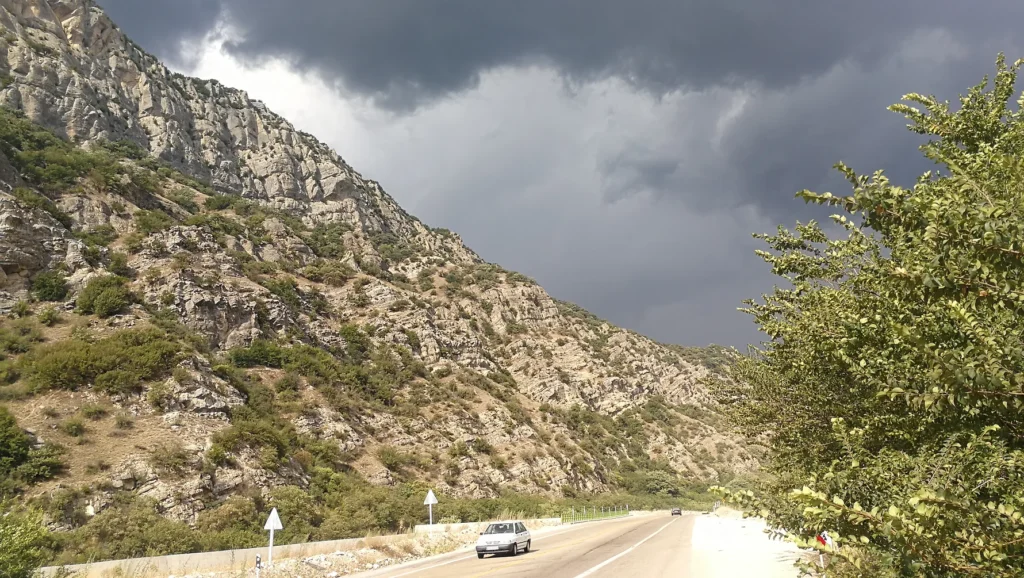
Today I saw about 30 wild bore – I assume they like being close to the road as in some areas people do picnics and the wild bore are fans of the leftovers.
I cycled late into the night as I hadn’t found a water source since hours and needed water before pitching camp. I ended up crossing the entire national park and when I coincidentally came by another Red Crescent site and asked if I could camp on their premises, I got another warm welcome to stay there for the night.
Let’s assume that the direction of our consciousness attention generally matters: “myself” vs. “others”, “my individual feelings” vs. “feeling into oneness” … we can focus our attention across all these concepts and we can do so striving for balance.
But what about the underlying emotional flavor with which we pay attention to these concepts?
Perhaps it matters more than our attention direction – whether we focus our attention on ourself or on others or on any other object in the universe, it makes a tremendous difference if we look into this direction “analytical-cold” or “with compassion”.
This applies to all things and objects and concepts we can focus on, including oneness. I don’t think a philosopher who cognitively “knows” about any particular oneness concept will experience a consciousness expansion into this direction without cultivating things like true compassion for the world and everything within it – including the philosopher himself or herself.
In the morning I had still wind cover while coming out of the Golestan National Park valley, then for the rest of the day I cycled in plains with a headwind so strong that it cut my average speed by half.
Cycling into headwind costs a lot of energy. But it definitely costs less energy with a positive attitude about it – just like in our consciousness when we first see a “hurdle” and re-frame it as an “opportunity to grow” … yes cheesy and said a million times before but true.
Who knows, perhaps such an attitude can also be applied to all the pain contained in oneness?
Another thunderstorm in the evening but if you have waterproof cloths it’s not really an issue. It’s funny how fast you get used to changing weather conditions on the bike.
I found a camping place during the storm and helped some Iranian campers to secure their belongings from being blown away. Here I also met another cycle tourer from Germany on his way to Mashhad.
Another day of headwind cycling – together it’s easier as you can take turns cycling in each other’s wind shadow.

We cycled over a long pass in the afternoon – I wonder how much snow they get here in winter.
On the downhill I set a new overall tour high-speed at 77 km/h. The bike remains stable at high velocities when things are packed well and the bags are well mounted … but with a loaded touring bike I probably wouldn’t go much faster.
In the evening we found a good wind-protected campspot behind a mudwall.
Another day of headwind cycling. In the evening we found a good wind-protected campspot in what was probably an an old stone quarry.
60 km before Mashhad we got water at a gorgeous rest area next to a gas station – some Iranian travelers directly camped here.
In Mashhad all hotels were full due the birthday of Iman Reza – born in the year 766 in Medina as a descendant of Muhammad he is still highly admired as spiritual leader.
In the third hotel the manager invited us to sleep in the hotel lobby on the floor and eat for free as long as we wanted – another Iranian encounter of warm hospitality.
I waited with excitement for the Turkmenistan embassy to decide about my transit visa – cycling on, or forced to disassemble the bike and fly somewhere in Central Asia? On the third day the Turkmenistan embassy gave green light and I could pick up the visa – I felt grateful.
In the evening I went to the Imam Reza Holy Shrine. It’s one of the world’s largest mosques but much more – it has so many massive courtyards that I lost count, several museums, and large halls that are breathtaking in their beauty.
What touched me most here was the living part of it – the humans coming here to pray, for sightseeing, or just to relax with family members and friends. This place has an atmosphere that felt natural and open to everyone.
What is the connection between spirituality and oneness?
I would say every human has an own and equally valid answer somewhere inside. Any belief system, be it spiritual or atheistic beliefs, is compatible with oneness – given that oneness is about detaching and leaving beliefs on “our side” of our dualistic mind behind, until both sides become one.
In my opinion we can all feel into the physical reality of everything the universe holds, its full expansion, and see where this journey leads us. I think we can all start experiencing this today, in any life situation, step by step, breath by breath.
And whenever we leave another cognitive concept-attachment behind and we allow us to feel beyond, something happens in our consciousness – just trust yourself and jump, it’s going to be ok.
Breathing in, breathing out.
Time to cycle to the Iran-Turkmenistan border crossing at Sarakhs. Three visa days in Iran left, 200 km desert ahead – the visa timing plan had worked out fine.
Today the Mashhad experience still resonated in me and I cycled all day deep in thoughts, even the headwind didn’t bother me.
In the evening I cycled into the dark and ended up sleeping in a sandy dry creek as it was the only spot around without thorns.
How does trust feel in our body and consciousness?
Perhaps like “familiar”, “right”, “safe”, “protected”, or “home”? Or perhaps like “relaxed observing” and “being certain”?
When we practice paying attention to our true feelings which can only be paraphrased by words, we find out more about who we really are – our authentic self embedded in something larger that you can feel too, independent of how you prefer to call it.
In the morning I luckily found a shop selling water. Iran was the first tour country where I never found water from a natural spring – perhaps it’s a mid-summer effect.
By 10:30am the heat was already glimmering above the road – I felt free and grateful for the fantastic cycling conditions in such a beautiful landscape.
Near Mazdavand the road goes over two steep ridges after which it’s basically a long downhill towards Turkmenistan.
After the ridges I raced the downhill hard – sometimes you just have to let the energy out.
Yes our life can be tough with the whole pain-of-the-world-universal-suffering-thing we all transcend through – but then again sometimes we are in the afternoon heat in a desert and suddenly there is a little shop selling us a cold Pepsi.
Does beauty lie in the eyes of the observer?
Wherever we grow up and whichever life path we follow, we are free inside to look at our life path with any attention we choose.
So how do you look at your life, dear reader?
Or does beauty lie in the heart of the observer?
True admiration for being alive goes beyond the mere thought of it – it’s something that feels warm.
In the evening I pitched camp in a bushland area where I slept on the ground – desert nights without a tent feel special.
A stormy warm wind shaked the bushes around me … I felt completely at ease and ready for further adventures. Sometimes being a consciousness pioneer is a simply fantastic experience.
Living from the heart, integrating our emotional biography, cultivating self-love, making our meditation a priority, listening more to our feelings – where does that lead us?
I would say it makes us more caring for ourselves and others and whatever we believe in, it makes our life experience deeper.
Stormy conditions in the morning but I was already close to the border crossing thus today’s speed was unimportant.
When I took a break my bike got blown over by a wind gust. Much more wind and cycling wouldn’t make sense anymore if it’s not tailwind.
I reached Sarakhs and bought 12 liter of water to be independent on my first day in Turkmenistan – surprisingly, in this border town I didn’t find anyone changing Rial to Manat.
The Persian culture was a good experience – people here have their heart in the right place.
In Saraks I had a look at a cheap hotel but then decided to cycle out of town and camp. The last days were among the best cycling days in Iran and I preferred to sleep my last night here as an adventurer – knowing that the true adventure of life is found inside ourself.
Iran, thank you for the impulses on oneness. On our further consciousness expedition, perhaps it’s a good idea to remember that everyone is on a consciousness journey through life.
Who knows, perhaps we all experience structurally a similar consciousness evolvement during our lifetime – I’m not sure … oneness is definitely a tricky concept to write about.




